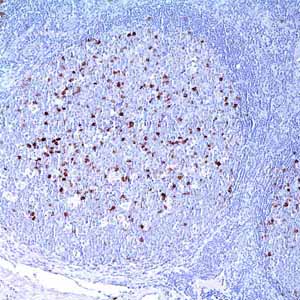
CD57 (NK-1)

CD57 is a marker expressed in the membrane of NK cells and other T cells.1 It is often used in the identification of nodular lymphocyte predominant Hodgkin lymphoma (NLPHL) to visualize the small T-cells that ring the LP cells (rosettes of follicular T cells around the large neoplastic LP cells). These features can be used to distinguish NLPHL from T-cell/histiocyte-rich large B-cell lymphoma, which usually shows no rosettes of CD57-positive follicular T-cells around the large tumor cells.2 Anti-CD57 also reacts with neuroendocrine cells and their derived tumors, including neuroendocrine tumors of diverse origins, pheochromocytomas, paragangliomas, medulloblastoma, and varying proportions of neural tumors such as schwannomas, neurofibromas, neuromas, and granular cell tumors.3 However, anti-CD57 lacks the specificity of chromogranin and synaptophysin for detecting neuroendocrine neoplasms and therefore should be considered in a panel.4 Anti-CD57 can also be useful in separating thymoma from thymic carcinoma when combined with a panel that includes antibodies against CD5 and CD117.5
